Report on Classical and Human Relations Organisation Theory
VerifiedAdded on 2020/12/18
|11
|2562
|411
Report
AI Summary
This report provides a comprehensive analysis of organisation theory, delving into both classical and human relations approaches. It begins by examining classical theories, including Taylor's scientific management, Fayol's administrative management, and Weber's bureaucratic theory, highlighting their strengths, weaknesses, and criticisms. The report then explores human relations theories, such as Elton Mayo's Hawthorne studies, Maslow's hierarchy of needs, Herzberg's two-factor theory, and McGregor's Theory X and Theory Y. Furthermore, the report discusses customer orientation, Handy's principles, and the Japanese model of management, providing a well-rounded understanding of organizational structures and management strategies. The conclusion summarizes the key findings and implications of the various theories presented.
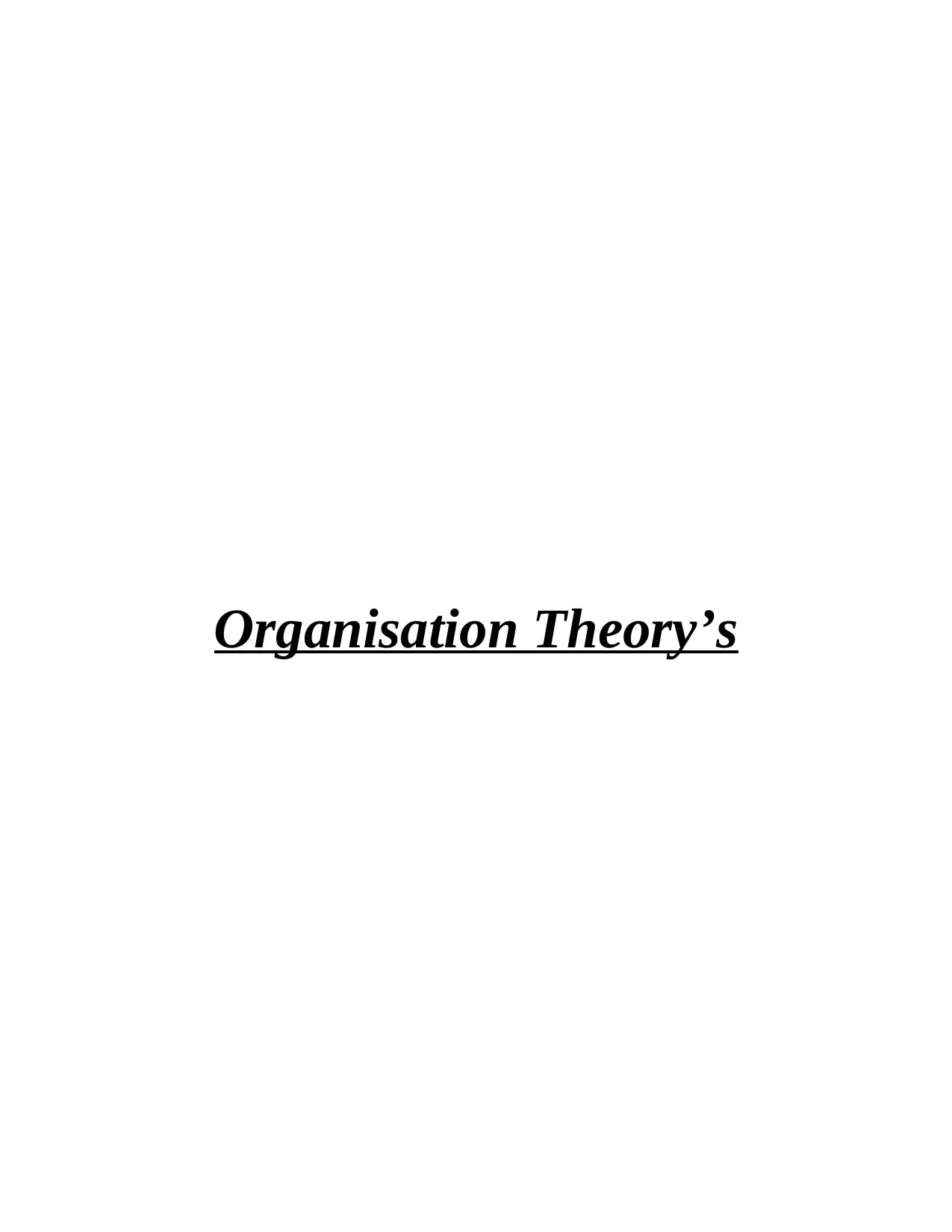
Organisation Theory’s
Paraphrase This Document
Need a fresh take? Get an instant paraphrase of this document with our AI Paraphraser

Table of Contents
INTRODUCTION...........................................................................................................................1
TASK 1 ...........................................................................................................................................1
TASK 2............................................................................................................................................5
CONCLUSION................................................................................................................................6
REFERENCES................................................................................................................................8
INTRODUCTION...........................................................................................................................1
TASK 1 ...........................................................................................................................................1
TASK 2............................................................................................................................................5
CONCLUSION................................................................................................................................6
REFERENCES................................................................................................................................8

⊘ This is a preview!⊘
Do you want full access?
Subscribe today to unlock all pages.

Trusted by 1+ million students worldwide
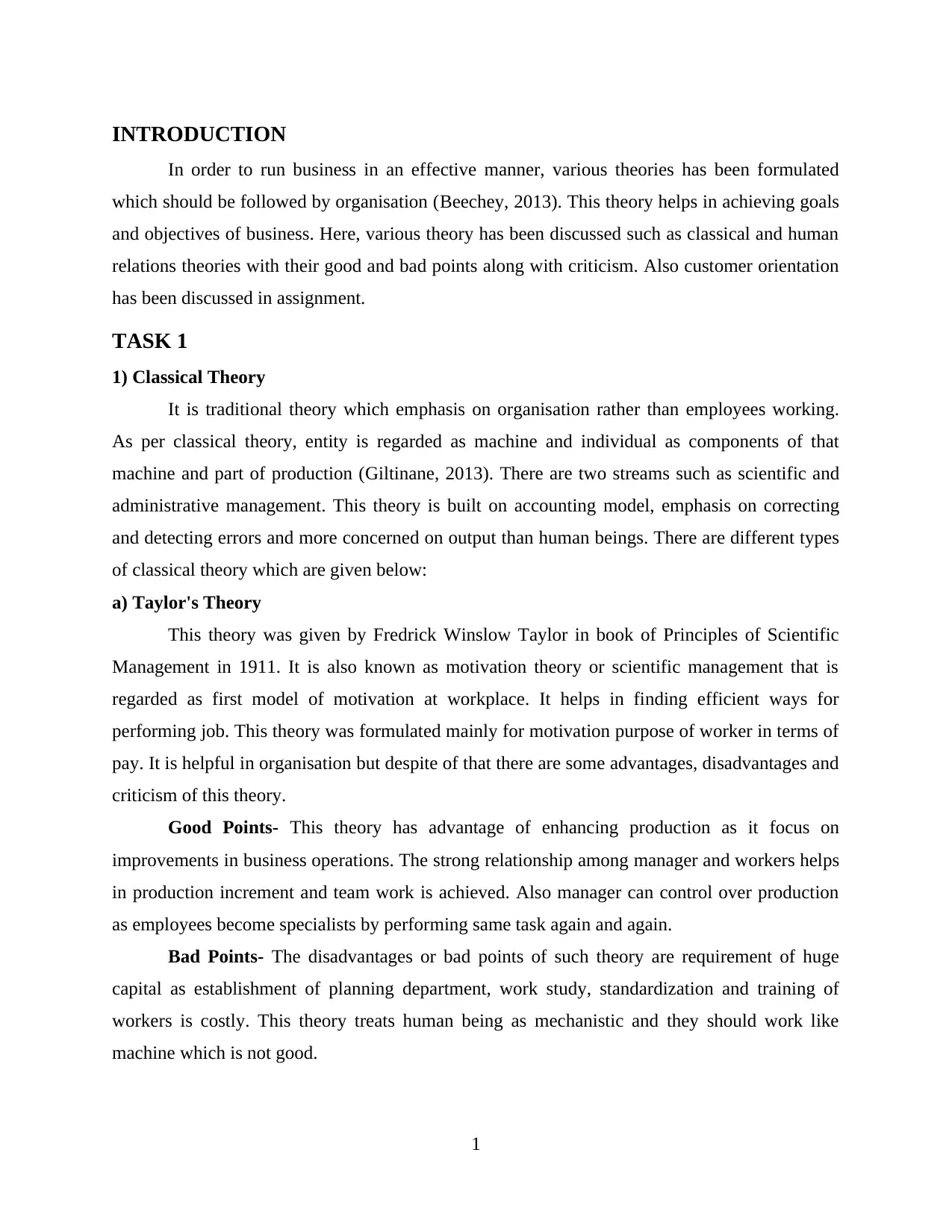
INTRODUCTION
In order to run business in an effective manner, various theories has been formulated
which should be followed by organisation (Beechey, 2013). This theory helps in achieving goals
and objectives of business. Here, various theory has been discussed such as classical and human
relations theories with their good and bad points along with criticism. Also customer orientation
has been discussed in assignment.
TASK 1
1) Classical Theory
It is traditional theory which emphasis on organisation rather than employees working.
As per classical theory, entity is regarded as machine and individual as components of that
machine and part of production (Giltinane, 2013). There are two streams such as scientific and
administrative management. This theory is built on accounting model, emphasis on correcting
and detecting errors and more concerned on output than human beings. There are different types
of classical theory which are given below:
a) Taylor's Theory
This theory was given by Fredrick Winslow Taylor in book of Principles of Scientific
Management in 1911. It is also known as motivation theory or scientific management that is
regarded as first model of motivation at workplace. It helps in finding efficient ways for
performing job. This theory was formulated mainly for motivation purpose of worker in terms of
pay. It is helpful in organisation but despite of that there are some advantages, disadvantages and
criticism of this theory.
Good Points- This theory has advantage of enhancing production as it focus on
improvements in business operations. The strong relationship among manager and workers helps
in production increment and team work is achieved. Also manager can control over production
as employees become specialists by performing same task again and again.
Bad Points- The disadvantages or bad points of such theory are requirement of huge
capital as establishment of planning department, work study, standardization and training of
workers is costly. This theory treats human being as mechanistic and they should work like
machine which is not good.
1
In order to run business in an effective manner, various theories has been formulated
which should be followed by organisation (Beechey, 2013). This theory helps in achieving goals
and objectives of business. Here, various theory has been discussed such as classical and human
relations theories with their good and bad points along with criticism. Also customer orientation
has been discussed in assignment.
TASK 1
1) Classical Theory
It is traditional theory which emphasis on organisation rather than employees working.
As per classical theory, entity is regarded as machine and individual as components of that
machine and part of production (Giltinane, 2013). There are two streams such as scientific and
administrative management. This theory is built on accounting model, emphasis on correcting
and detecting errors and more concerned on output than human beings. There are different types
of classical theory which are given below:
a) Taylor's Theory
This theory was given by Fredrick Winslow Taylor in book of Principles of Scientific
Management in 1911. It is also known as motivation theory or scientific management that is
regarded as first model of motivation at workplace. It helps in finding efficient ways for
performing job. This theory was formulated mainly for motivation purpose of worker in terms of
pay. It is helpful in organisation but despite of that there are some advantages, disadvantages and
criticism of this theory.
Good Points- This theory has advantage of enhancing production as it focus on
improvements in business operations. The strong relationship among manager and workers helps
in production increment and team work is achieved. Also manager can control over production
as employees become specialists by performing same task again and again.
Bad Points- The disadvantages or bad points of such theory are requirement of huge
capital as establishment of planning department, work study, standardization and training of
workers is costly. This theory treats human being as mechanistic and they should work like
machine which is not good.
1
Paraphrase This Document
Need a fresh take? Get an instant paraphrase of this document with our AI Paraphraser

Criticism- This theory used functional foremanship where employees has to report to
eight bosses which leads problem of unity of command. Also, it exploit worker as management
put employees under unnecessary pressure to perform work faster. This creates mistrust among
staff and management.
b) Fayol's Theory
This theory was given by Henri Fayol in 1925 which focus on 14 principles that serves as
guideline for management actions and decision making (Iyamu, 2013). Fayol emphasis that
management should do interaction with individuals in different ways for better plan production
and control which can be in terms of planning, organising, commanding, coordinating and
controlling.
Good Points- This theory helps in defining role of manager effectively and efficiently
which is clear direction for them to follow their roles and responsibility. The efficiency of
organisational structure increases along with effectiveness in administrative activities.
Bad Points- The principles of this theory explains vision rather than reality which is
based on Fayol's own experience rather than empirical research. The manager explain their own
role without considering employee feeling and they spend little time for carrying principles and
rely more on personal contacts and cultivating workforce.
Criticism- This theory is based on management oriented where problems of workers are
not given too much attention and does not give important to informal organisation or groups. It
does not give significant to communication, leading and motivation which is also criticise by
people.
c) Weber's Theory
This theory is also known as Bureaucratic given by Max Weber in 1905. It focus on
bureaucracy which is most efficient way to set organisation and administrations (Mason,
Kjellberg and Hagberg, 2015). This helps in treating all employees equally and division is clearly
described from each employees.
Good Points- The good points of this theory is that based on specialisation where each
and every member is assigned to perform specialised task. It follows common structure which
specifies duties and responsibilities and reporting within hierarchy.
2
eight bosses which leads problem of unity of command. Also, it exploit worker as management
put employees under unnecessary pressure to perform work faster. This creates mistrust among
staff and management.
b) Fayol's Theory
This theory was given by Henri Fayol in 1925 which focus on 14 principles that serves as
guideline for management actions and decision making (Iyamu, 2013). Fayol emphasis that
management should do interaction with individuals in different ways for better plan production
and control which can be in terms of planning, organising, commanding, coordinating and
controlling.
Good Points- This theory helps in defining role of manager effectively and efficiently
which is clear direction for them to follow their roles and responsibility. The efficiency of
organisational structure increases along with effectiveness in administrative activities.
Bad Points- The principles of this theory explains vision rather than reality which is
based on Fayol's own experience rather than empirical research. The manager explain their own
role without considering employee feeling and they spend little time for carrying principles and
rely more on personal contacts and cultivating workforce.
Criticism- This theory is based on management oriented where problems of workers are
not given too much attention and does not give important to informal organisation or groups. It
does not give significant to communication, leading and motivation which is also criticise by
people.
c) Weber's Theory
This theory is also known as Bureaucratic given by Max Weber in 1905. It focus on
bureaucracy which is most efficient way to set organisation and administrations (Mason,
Kjellberg and Hagberg, 2015). This helps in treating all employees equally and division is clearly
described from each employees.
Good Points- The good points of this theory is that based on specialisation where each
and every member is assigned to perform specialised task. It follows common structure which
specifies duties and responsibilities and reporting within hierarchy.
2
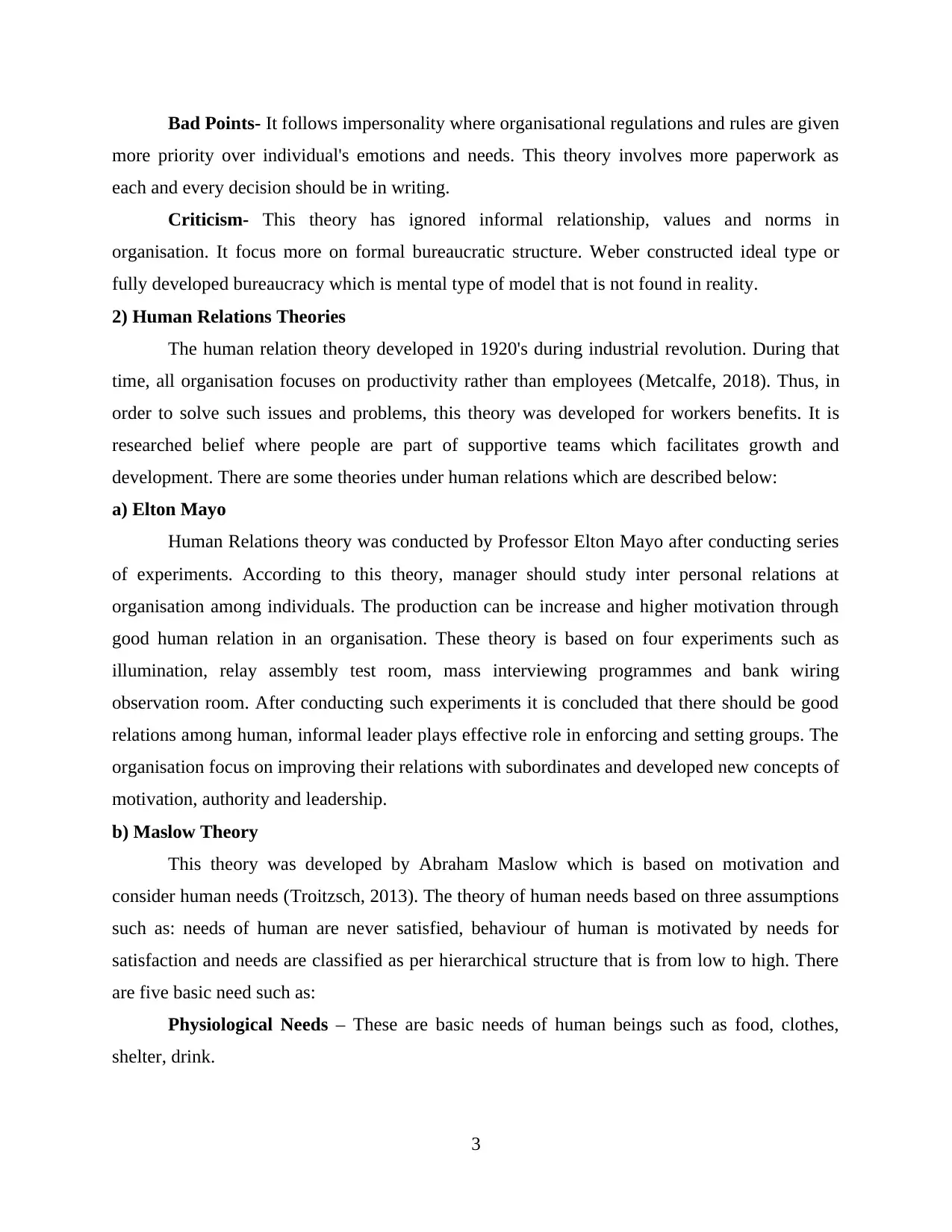
Bad Points- It follows impersonality where organisational regulations and rules are given
more priority over individual's emotions and needs. This theory involves more paperwork as
each and every decision should be in writing.
Criticism- This theory has ignored informal relationship, values and norms in
organisation. It focus more on formal bureaucratic structure. Weber constructed ideal type or
fully developed bureaucracy which is mental type of model that is not found in reality.
2) Human Relations Theories
The human relation theory developed in 1920's during industrial revolution. During that
time, all organisation focuses on productivity rather than employees (Metcalfe, 2018). Thus, in
order to solve such issues and problems, this theory was developed for workers benefits. It is
researched belief where people are part of supportive teams which facilitates growth and
development. There are some theories under human relations which are described below:
a) Elton Mayo
Human Relations theory was conducted by Professor Elton Mayo after conducting series
of experiments. According to this theory, manager should study inter personal relations at
organisation among individuals. The production can be increase and higher motivation through
good human relation in an organisation. These theory is based on four experiments such as
illumination, relay assembly test room, mass interviewing programmes and bank wiring
observation room. After conducting such experiments it is concluded that there should be good
relations among human, informal leader plays effective role in enforcing and setting groups. The
organisation focus on improving their relations with subordinates and developed new concepts of
motivation, authority and leadership.
b) Maslow Theory
This theory was developed by Abraham Maslow which is based on motivation and
consider human needs (Troitzsch, 2013). The theory of human needs based on three assumptions
such as: needs of human are never satisfied, behaviour of human is motivated by needs for
satisfaction and needs are classified as per hierarchical structure that is from low to high. There
are five basic need such as:
Physiological Needs – These are basic needs of human beings such as food, clothes,
shelter, drink.
3
more priority over individual's emotions and needs. This theory involves more paperwork as
each and every decision should be in writing.
Criticism- This theory has ignored informal relationship, values and norms in
organisation. It focus more on formal bureaucratic structure. Weber constructed ideal type or
fully developed bureaucracy which is mental type of model that is not found in reality.
2) Human Relations Theories
The human relation theory developed in 1920's during industrial revolution. During that
time, all organisation focuses on productivity rather than employees (Metcalfe, 2018). Thus, in
order to solve such issues and problems, this theory was developed for workers benefits. It is
researched belief where people are part of supportive teams which facilitates growth and
development. There are some theories under human relations which are described below:
a) Elton Mayo
Human Relations theory was conducted by Professor Elton Mayo after conducting series
of experiments. According to this theory, manager should study inter personal relations at
organisation among individuals. The production can be increase and higher motivation through
good human relation in an organisation. These theory is based on four experiments such as
illumination, relay assembly test room, mass interviewing programmes and bank wiring
observation room. After conducting such experiments it is concluded that there should be good
relations among human, informal leader plays effective role in enforcing and setting groups. The
organisation focus on improving their relations with subordinates and developed new concepts of
motivation, authority and leadership.
b) Maslow Theory
This theory was developed by Abraham Maslow which is based on motivation and
consider human needs (Troitzsch, 2013). The theory of human needs based on three assumptions
such as: needs of human are never satisfied, behaviour of human is motivated by needs for
satisfaction and needs are classified as per hierarchical structure that is from low to high. There
are five basic need such as:
Physiological Needs – These are basic needs of human beings such as food, clothes,
shelter, drink.
3
⊘ This is a preview!⊘
Do you want full access?
Subscribe today to unlock all pages.

Trusted by 1+ million students worldwide
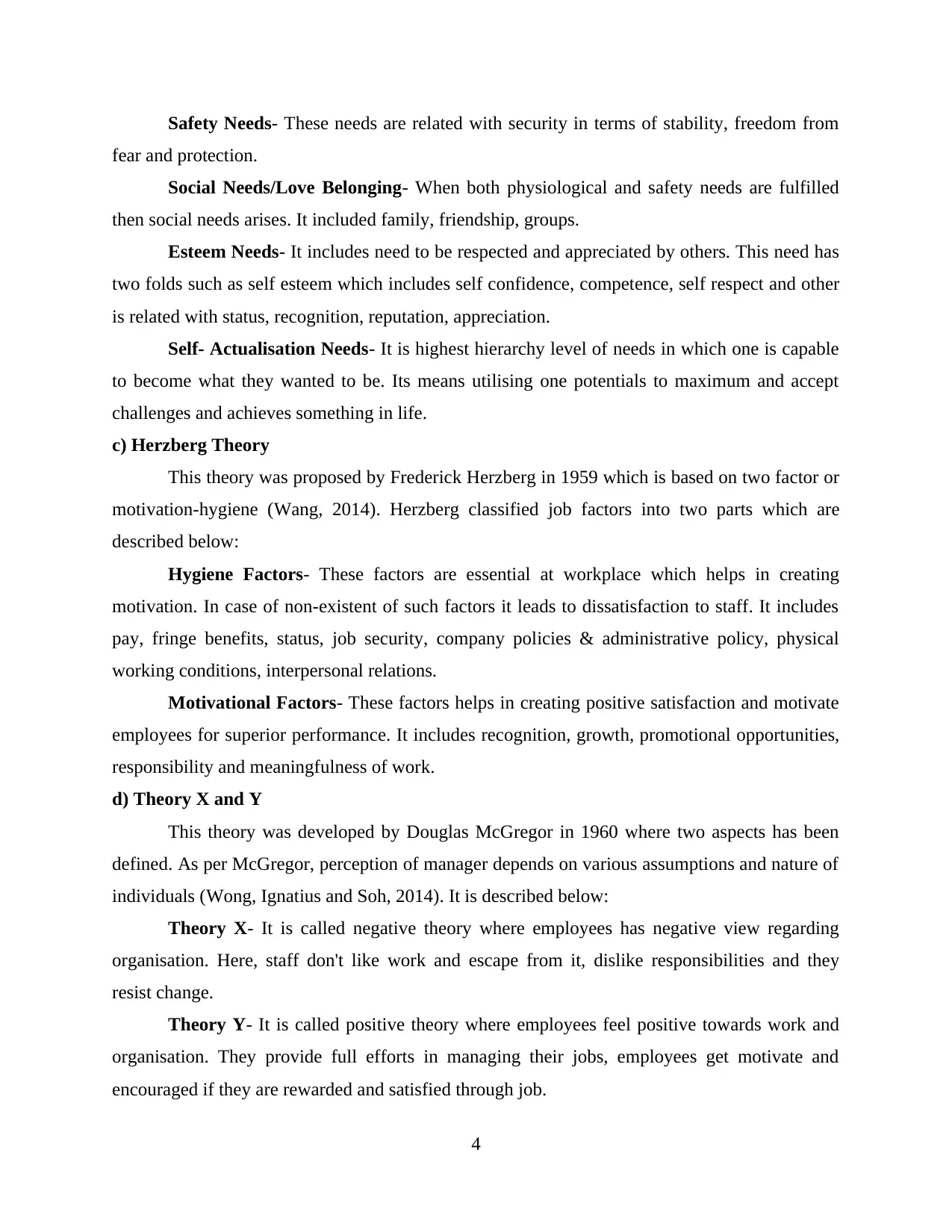
Safety Needs- These needs are related with security in terms of stability, freedom from
fear and protection.
Social Needs/Love Belonging- When both physiological and safety needs are fulfilled
then social needs arises. It included family, friendship, groups.
Esteem Needs- It includes need to be respected and appreciated by others. This need has
two folds such as self esteem which includes self confidence, competence, self respect and other
is related with status, recognition, reputation, appreciation.
Self- Actualisation Needs- It is highest hierarchy level of needs in which one is capable
to become what they wanted to be. Its means utilising one potentials to maximum and accept
challenges and achieves something in life.
c) Herzberg Theory
This theory was proposed by Frederick Herzberg in 1959 which is based on two factor or
motivation-hygiene (Wang, 2014). Herzberg classified job factors into two parts which are
described below:
Hygiene Factors- These factors are essential at workplace which helps in creating
motivation. In case of non-existent of such factors it leads to dissatisfaction to staff. It includes
pay, fringe benefits, status, job security, company policies & administrative policy, physical
working conditions, interpersonal relations.
Motivational Factors- These factors helps in creating positive satisfaction and motivate
employees for superior performance. It includes recognition, growth, promotional opportunities,
responsibility and meaningfulness of work.
d) Theory X and Y
This theory was developed by Douglas McGregor in 1960 where two aspects has been
defined. As per McGregor, perception of manager depends on various assumptions and nature of
individuals (Wong, Ignatius and Soh, 2014). It is described below:
Theory X- It is called negative theory where employees has negative view regarding
organisation. Here, staff don't like work and escape from it, dislike responsibilities and they
resist change.
Theory Y- It is called positive theory where employees feel positive towards work and
organisation. They provide full efforts in managing their jobs, employees get motivate and
encouraged if they are rewarded and satisfied through job.
4
fear and protection.
Social Needs/Love Belonging- When both physiological and safety needs are fulfilled
then social needs arises. It included family, friendship, groups.
Esteem Needs- It includes need to be respected and appreciated by others. This need has
two folds such as self esteem which includes self confidence, competence, self respect and other
is related with status, recognition, reputation, appreciation.
Self- Actualisation Needs- It is highest hierarchy level of needs in which one is capable
to become what they wanted to be. Its means utilising one potentials to maximum and accept
challenges and achieves something in life.
c) Herzberg Theory
This theory was proposed by Frederick Herzberg in 1959 which is based on two factor or
motivation-hygiene (Wang, 2014). Herzberg classified job factors into two parts which are
described below:
Hygiene Factors- These factors are essential at workplace which helps in creating
motivation. In case of non-existent of such factors it leads to dissatisfaction to staff. It includes
pay, fringe benefits, status, job security, company policies & administrative policy, physical
working conditions, interpersonal relations.
Motivational Factors- These factors helps in creating positive satisfaction and motivate
employees for superior performance. It includes recognition, growth, promotional opportunities,
responsibility and meaningfulness of work.
d) Theory X and Y
This theory was developed by Douglas McGregor in 1960 where two aspects has been
defined. As per McGregor, perception of manager depends on various assumptions and nature of
individuals (Wong, Ignatius and Soh, 2014). It is described below:
Theory X- It is called negative theory where employees has negative view regarding
organisation. Here, staff don't like work and escape from it, dislike responsibilities and they
resist change.
Theory Y- It is called positive theory where employees feel positive towards work and
organisation. They provide full efforts in managing their jobs, employees get motivate and
encouraged if they are rewarded and satisfied through job.
4
Paraphrase This Document
Need a fresh take? Get an instant paraphrase of this document with our AI Paraphraser
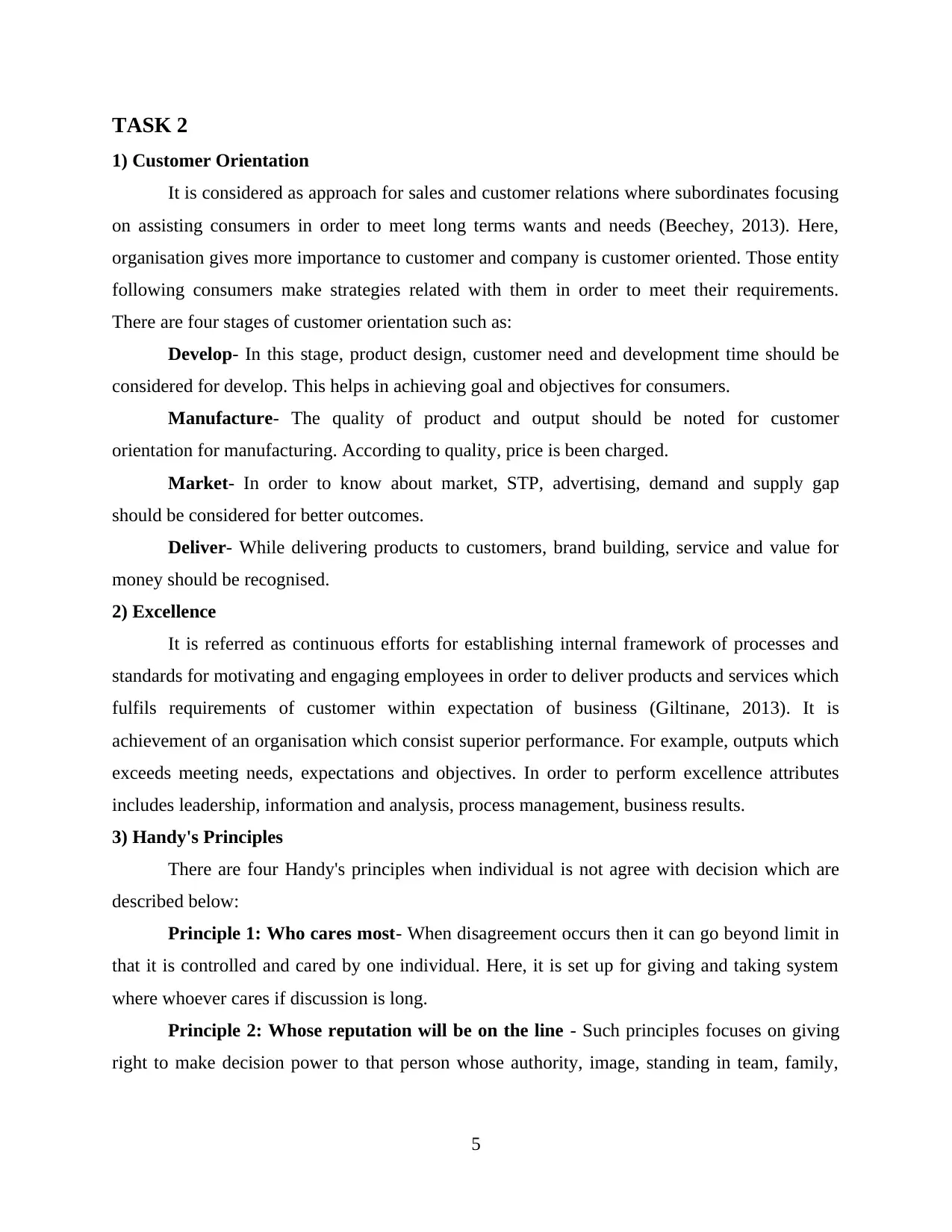
TASK 2
1) Customer Orientation
It is considered as approach for sales and customer relations where subordinates focusing
on assisting consumers in order to meet long terms wants and needs (Beechey, 2013). Here,
organisation gives more importance to customer and company is customer oriented. Those entity
following consumers make strategies related with them in order to meet their requirements.
There are four stages of customer orientation such as:
Develop- In this stage, product design, customer need and development time should be
considered for develop. This helps in achieving goal and objectives for consumers.
Manufacture- The quality of product and output should be noted for customer
orientation for manufacturing. According to quality, price is been charged.
Market- In order to know about market, STP, advertising, demand and supply gap
should be considered for better outcomes.
Deliver- While delivering products to customers, brand building, service and value for
money should be recognised.
2) Excellence
It is referred as continuous efforts for establishing internal framework of processes and
standards for motivating and engaging employees in order to deliver products and services which
fulfils requirements of customer within expectation of business (Giltinane, 2013). It is
achievement of an organisation which consist superior performance. For example, outputs which
exceeds meeting needs, expectations and objectives. In order to perform excellence attributes
includes leadership, information and analysis, process management, business results.
3) Handy's Principles
There are four Handy's principles when individual is not agree with decision which are
described below:
Principle 1: Who cares most- When disagreement occurs then it can go beyond limit in
that it is controlled and cared by one individual. Here, it is set up for giving and taking system
where whoever cares if discussion is long.
Principle 2: Whose reputation will be on the line - Such principles focuses on giving
right to make decision power to that person whose authority, image, standing in team, family,
5
1) Customer Orientation
It is considered as approach for sales and customer relations where subordinates focusing
on assisting consumers in order to meet long terms wants and needs (Beechey, 2013). Here,
organisation gives more importance to customer and company is customer oriented. Those entity
following consumers make strategies related with them in order to meet their requirements.
There are four stages of customer orientation such as:
Develop- In this stage, product design, customer need and development time should be
considered for develop. This helps in achieving goal and objectives for consumers.
Manufacture- The quality of product and output should be noted for customer
orientation for manufacturing. According to quality, price is been charged.
Market- In order to know about market, STP, advertising, demand and supply gap
should be considered for better outcomes.
Deliver- While delivering products to customers, brand building, service and value for
money should be recognised.
2) Excellence
It is referred as continuous efforts for establishing internal framework of processes and
standards for motivating and engaging employees in order to deliver products and services which
fulfils requirements of customer within expectation of business (Giltinane, 2013). It is
achievement of an organisation which consist superior performance. For example, outputs which
exceeds meeting needs, expectations and objectives. In order to perform excellence attributes
includes leadership, information and analysis, process management, business results.
3) Handy's Principles
There are four Handy's principles when individual is not agree with decision which are
described below:
Principle 1: Who cares most- When disagreement occurs then it can go beyond limit in
that it is controlled and cared by one individual. Here, it is set up for giving and taking system
where whoever cares if discussion is long.
Principle 2: Whose reputation will be on the line - Such principles focuses on giving
right to make decision power to that person whose authority, image, standing in team, family,
5
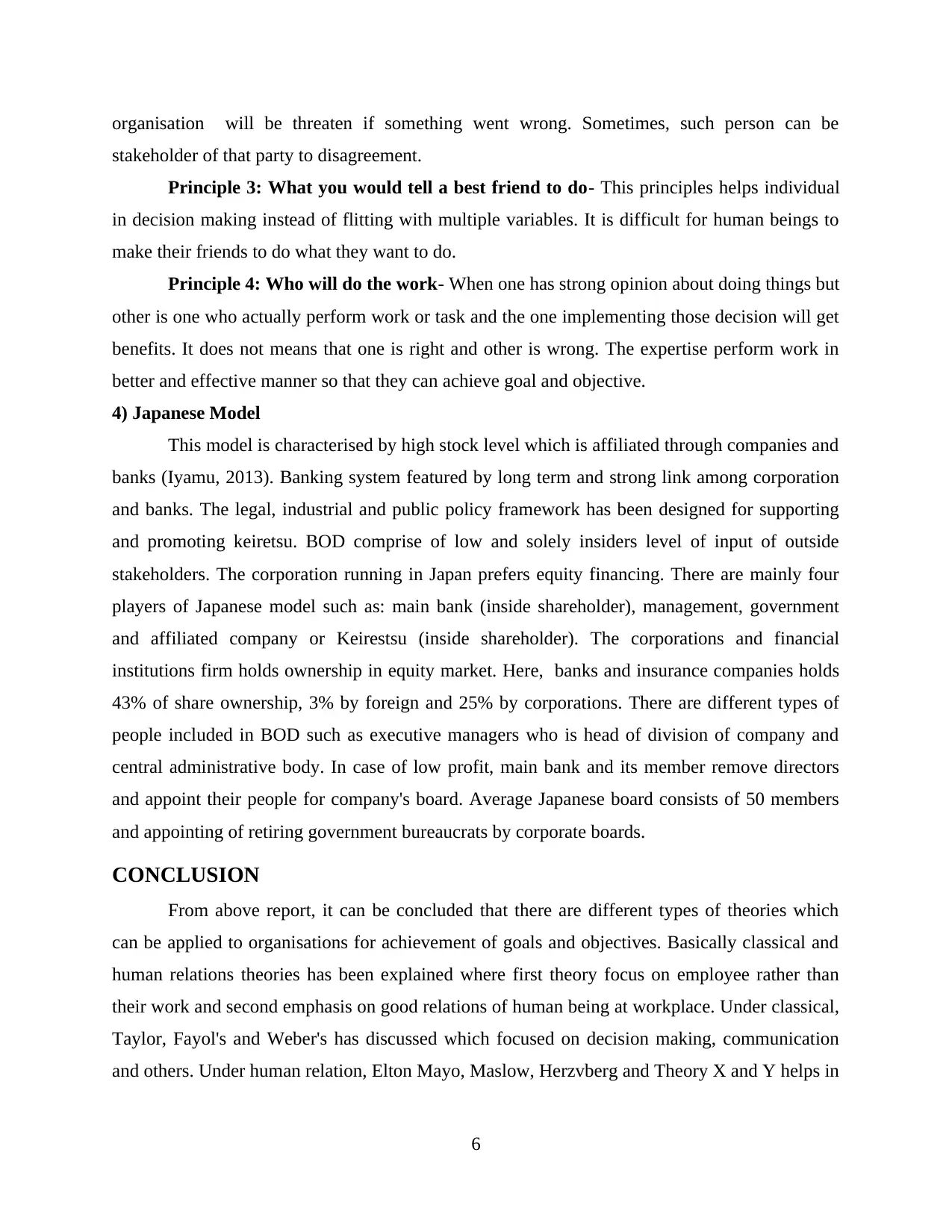
organisation will be threaten if something went wrong. Sometimes, such person can be
stakeholder of that party to disagreement.
Principle 3: What you would tell a best friend to do- This principles helps individual
in decision making instead of flitting with multiple variables. It is difficult for human beings to
make their friends to do what they want to do.
Principle 4: Who will do the work- When one has strong opinion about doing things but
other is one who actually perform work or task and the one implementing those decision will get
benefits. It does not means that one is right and other is wrong. The expertise perform work in
better and effective manner so that they can achieve goal and objective.
4) Japanese Model
This model is characterised by high stock level which is affiliated through companies and
banks (Iyamu, 2013). Banking system featured by long term and strong link among corporation
and banks. The legal, industrial and public policy framework has been designed for supporting
and promoting keiretsu. BOD comprise of low and solely insiders level of input of outside
stakeholders. The corporation running in Japan prefers equity financing. There are mainly four
players of Japanese model such as: main bank (inside shareholder), management, government
and affiliated company or Keirestsu (inside shareholder). The corporations and financial
institutions firm holds ownership in equity market. Here, banks and insurance companies holds
43% of share ownership, 3% by foreign and 25% by corporations. There are different types of
people included in BOD such as executive managers who is head of division of company and
central administrative body. In case of low profit, main bank and its member remove directors
and appoint their people for company's board. Average Japanese board consists of 50 members
and appointing of retiring government bureaucrats by corporate boards.
CONCLUSION
From above report, it can be concluded that there are different types of theories which
can be applied to organisations for achievement of goals and objectives. Basically classical and
human relations theories has been explained where first theory focus on employee rather than
their work and second emphasis on good relations of human being at workplace. Under classical,
Taylor, Fayol's and Weber's has discussed which focused on decision making, communication
and others. Under human relation, Elton Mayo, Maslow, Herzvberg and Theory X and Y helps in
6
stakeholder of that party to disagreement.
Principle 3: What you would tell a best friend to do- This principles helps individual
in decision making instead of flitting with multiple variables. It is difficult for human beings to
make their friends to do what they want to do.
Principle 4: Who will do the work- When one has strong opinion about doing things but
other is one who actually perform work or task and the one implementing those decision will get
benefits. It does not means that one is right and other is wrong. The expertise perform work in
better and effective manner so that they can achieve goal and objective.
4) Japanese Model
This model is characterised by high stock level which is affiliated through companies and
banks (Iyamu, 2013). Banking system featured by long term and strong link among corporation
and banks. The legal, industrial and public policy framework has been designed for supporting
and promoting keiretsu. BOD comprise of low and solely insiders level of input of outside
stakeholders. The corporation running in Japan prefers equity financing. There are mainly four
players of Japanese model such as: main bank (inside shareholder), management, government
and affiliated company or Keirestsu (inside shareholder). The corporations and financial
institutions firm holds ownership in equity market. Here, banks and insurance companies holds
43% of share ownership, 3% by foreign and 25% by corporations. There are different types of
people included in BOD such as executive managers who is head of division of company and
central administrative body. In case of low profit, main bank and its member remove directors
and appoint their people for company's board. Average Japanese board consists of 50 members
and appointing of retiring government bureaucrats by corporate boards.
CONCLUSION
From above report, it can be concluded that there are different types of theories which
can be applied to organisations for achievement of goals and objectives. Basically classical and
human relations theories has been explained where first theory focus on employee rather than
their work and second emphasis on good relations of human being at workplace. Under classical,
Taylor, Fayol's and Weber's has discussed which focused on decision making, communication
and others. Under human relation, Elton Mayo, Maslow, Herzvberg and Theory X and Y helps in
6
⊘ This is a preview!⊘
Do you want full access?
Subscribe today to unlock all pages.

Trusted by 1+ million students worldwide

motivating staff and helps in achievement of goals and objectives. Customer orientation assists in
maintaining good relationship with consumer and employees.
7
maintaining good relationship with consumer and employees.
7
Paraphrase This Document
Need a fresh take? Get an instant paraphrase of this document with our AI Paraphraser
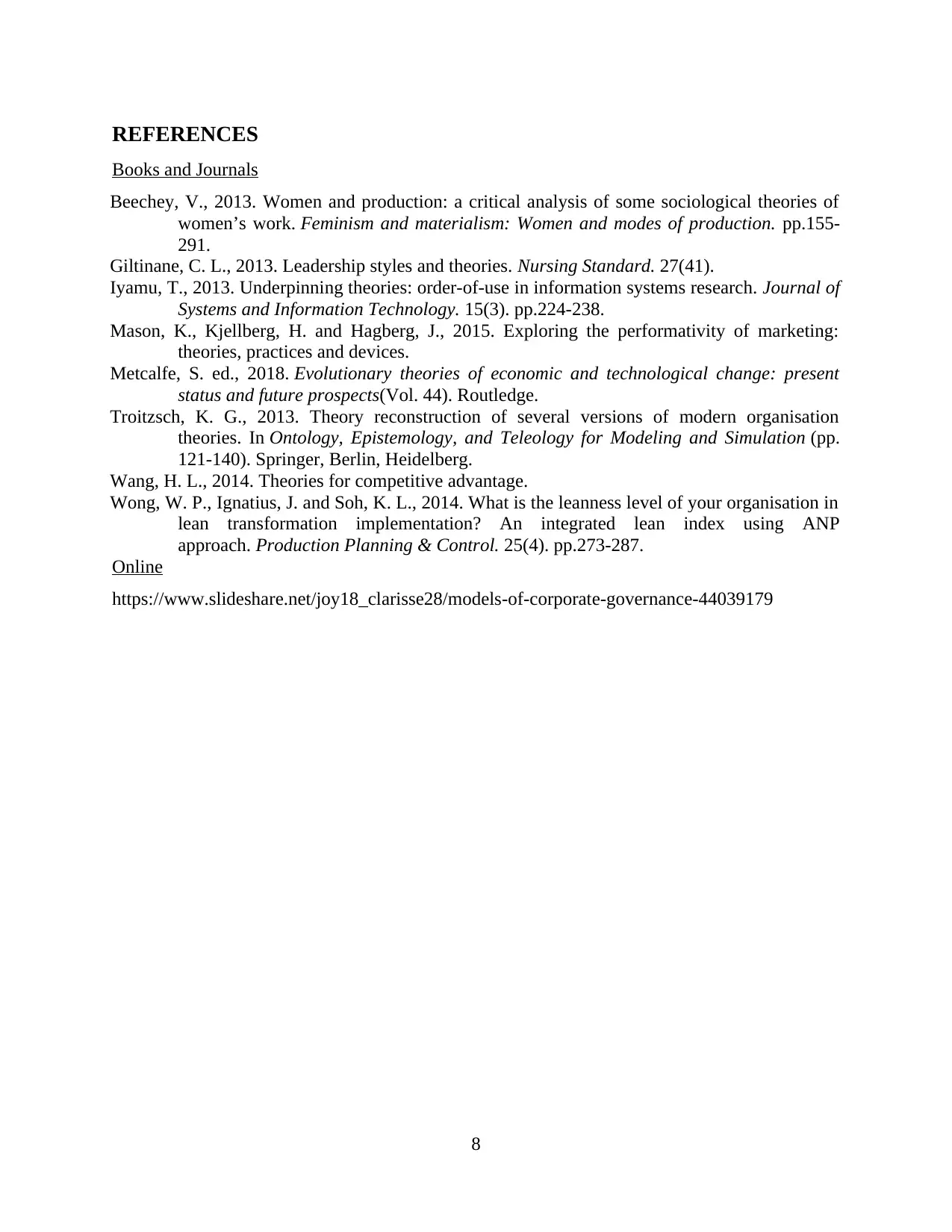
REFERENCES
Books and Journals
Beechey, V., 2013. Women and production: a critical analysis of some sociological theories of
women’s work. Feminism and materialism: Women and modes of production. pp.155-
291.
Giltinane, C. L., 2013. Leadership styles and theories. Nursing Standard. 27(41).
Iyamu, T., 2013. Underpinning theories: order-of-use in information systems research. Journal of
Systems and Information Technology. 15(3). pp.224-238.
Mason, K., Kjellberg, H. and Hagberg, J., 2015. Exploring the performativity of marketing:
theories, practices and devices.
Metcalfe, S. ed., 2018. Evolutionary theories of economic and technological change: present
status and future prospects(Vol. 44). Routledge.
Troitzsch, K. G., 2013. Theory reconstruction of several versions of modern organisation
theories. In Ontology, Epistemology, and Teleology for Modeling and Simulation (pp.
121-140). Springer, Berlin, Heidelberg.
Wang, H. L., 2014. Theories for competitive advantage.
Wong, W. P., Ignatius, J. and Soh, K. L., 2014. What is the leanness level of your organisation in
lean transformation implementation? An integrated lean index using ANP
approach. Production Planning & Control. 25(4). pp.273-287.
Online
https://www.slideshare.net/joy18_clarisse28/models-of-corporate-governance-44039179
8
Books and Journals
Beechey, V., 2013. Women and production: a critical analysis of some sociological theories of
women’s work. Feminism and materialism: Women and modes of production. pp.155-
291.
Giltinane, C. L., 2013. Leadership styles and theories. Nursing Standard. 27(41).
Iyamu, T., 2013. Underpinning theories: order-of-use in information systems research. Journal of
Systems and Information Technology. 15(3). pp.224-238.
Mason, K., Kjellberg, H. and Hagberg, J., 2015. Exploring the performativity of marketing:
theories, practices and devices.
Metcalfe, S. ed., 2018. Evolutionary theories of economic and technological change: present
status and future prospects(Vol. 44). Routledge.
Troitzsch, K. G., 2013. Theory reconstruction of several versions of modern organisation
theories. In Ontology, Epistemology, and Teleology for Modeling and Simulation (pp.
121-140). Springer, Berlin, Heidelberg.
Wang, H. L., 2014. Theories for competitive advantage.
Wong, W. P., Ignatius, J. and Soh, K. L., 2014. What is the leanness level of your organisation in
lean transformation implementation? An integrated lean index using ANP
approach. Production Planning & Control. 25(4). pp.273-287.
Online
https://www.slideshare.net/joy18_clarisse28/models-of-corporate-governance-44039179
8
1 out of 11
Related Documents
Your All-in-One AI-Powered Toolkit for Academic Success.
+13062052269
info@desklib.com
Available 24*7 on WhatsApp / Email
![[object Object]](/_next/static/media/star-bottom.7253800d.svg)
Unlock your academic potential
Copyright © 2020–2025 A2Z Services. All Rights Reserved. Developed and managed by ZUCOL.





